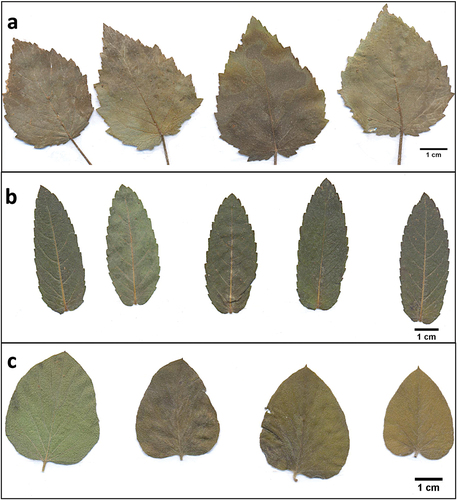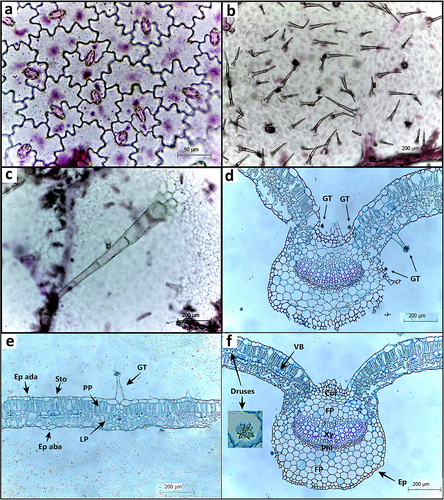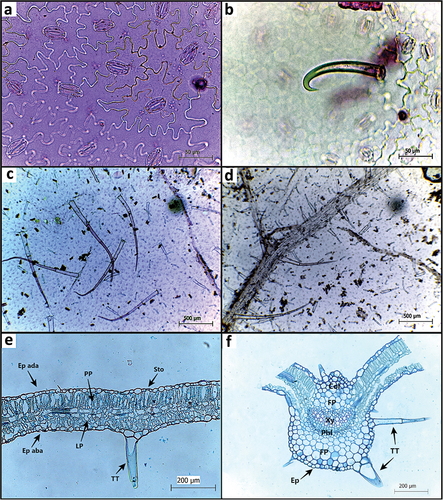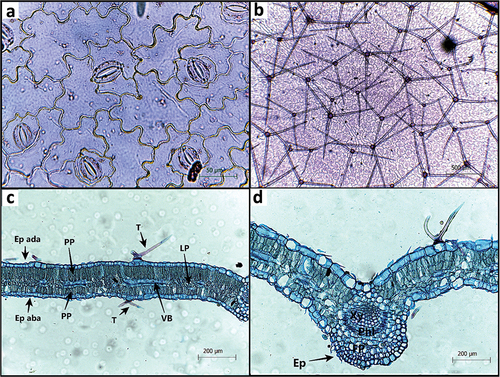Figures & data
Table 1. Average soil moisture, vapor pressure deficits, and photosynthetic photon flux densities in sites with different regeneration periods (22 years, R22; 44 years, R44; and more than 60 years, R > 60) after land abandonment, in a northeastern Brazilian seasonally dry tropical forest (Santa Teresinha, Paraíba state, Brazil).
Figure 1. Morphological characteristics of the leaves of Mesosphaerum suaveolens (A), Stachytarpheta sanguinea (B) and Jacquemontia evolvuloides (C) harvested from individuals growing in sites with different regeneration periods after land abandonment in a northeastern Brazilian seasonally dry tropical forest (Santa Teresinha, Paraíba state, Brazil).

Table 2. Morphological characteristics in leaves of three herbaceous species (one tall, one short, and one climbing species) growing in forest sites with different regeneration periods after land abandonment in a northeastern Brazilian seasonally dry tropical forest (Santa Teresinha, Paraíba state, Brazil).
Figure 2. Mesosphaerum suaveolens harvested from individuals growing in sites with different regeneration periods after land abandonment in a northeastern Brazilian seasonally dry tropical forest (Santa Teresinha, Paraíba state, Brazil). Diacytic stomata; tector and glandular trichomes in frontal view (A-C); cross-section of leaf blade (D-E) and midrib (F). (D) GT = trichomes; (E) PP = palisade parenchyma; LP = lacunar parenchyma; ep aba = abaxial epidermis; ep ada = adaxial epidermis; (F) VB = vascular bundle; ep = epidermis; FP = fundamental parenchyma; Phl= phloem; xy = xylem; col = collenchyma;; sto = stomata.

Figure 3. Stachytarpheta sanguinea harvested from individuals growing in sites with different regeneration periods after land abandonment in a northeastern Brazilian seasonally dry tropical forest (Santa Teresinha, Paraíba state, Brazil). Diacytic stomata on the adaxial leaf surface; hook-shaped tector trichomes; multicellular tector trichomes; tector trichomes at high density in the vein (A-D) in frontal view; cross-section of leaf blade (E) and midrib (F). (E) PP = palisade parenchyma; LP = lacunar parenchyma; TT = tector trichomes; sto = stomata; ep aba = abaxial epidermis; ep ada = adaxial epidermis; (F) ep = epidermis; FP = fundamental parenchyma; phl = phloem; xy = xylem; col = collenchyma; TT = tector trichomes.

Figure 4. Jacquemontia evolvuloides leaves harvested from individuals growing in sites with different regeneration periods after land abandonment in a northeastern Brazilian seasonally dry tropical forest (Santa Teresinha, Paraíba state, Brazil). Paracytic stomata and star-shaped tector trichomes (A-B) in frontal view; cross-section of leaf blade (C) and midrib (D). (C) PP = palisade parenchyma; LP = lacunar parenchyma; T = trichome; ep aba = abaxial epidermis; ep ada = adaxial epidermis; (D) ep = epidermis; FP = fundamental parenchyma; phl = phloem; xy = xylem.

Table 3. Morphometric characteristics in leaves of three herbaceous species (one tall, one short, and one climbing species) growing in sites with different regeneration periods after land abandonment in a northeastern Brazilian seasonally dry tropical forest (Santa Teresinha, Paraíba state, Brazil).
